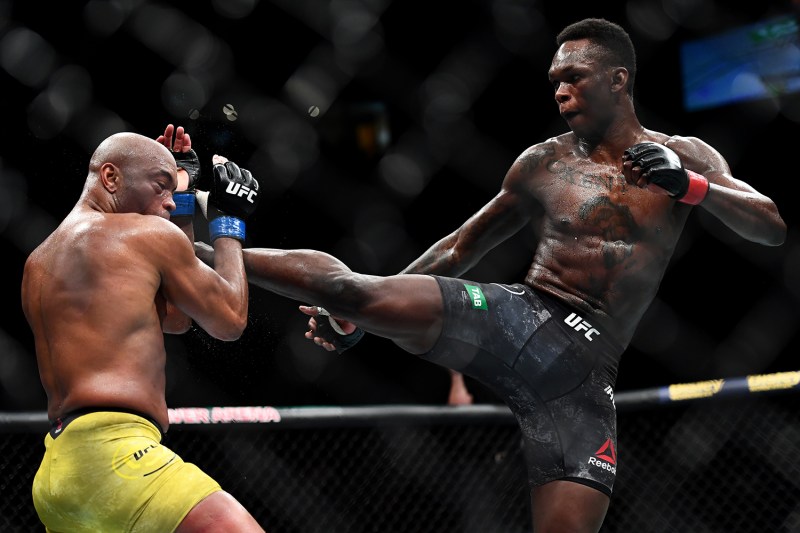
Before he appeared as the character Random Task in Austin Powers: International Man of Mystery and California inmate #AI7266, Joe Son was just an up-and-coming mixed martial arts fighter. The Ultimate Fighting Championship was only a few years old, and making it into the quarterfinals of UFC 4 was a big deal. Son was confident facing off against Keith Hackney. But a recently changed rule was about to end Son’s run, contributing to the reformation of the sport and the establishment of all UFC men wearing cups. After the events of the evening, it was definitely for the better.
History of UFC’s Cup Rule
When the UFC debuted in 1993, it only had a few rules, one of which was outlawing groin strikes. What would happen if a fighter struck his opponent in the Tractor Supply? It’s hard to say, as it never happened. But with pre-internet viral fame of the UFC and its no-holds-barred bad boy image came an even more lax set of rules, and beginning at UFC 2, punches and kicks to the Orange Julius were fair game. It’s with this switch that Son and Hackney met head on.
The fight started with the pair exchanging shots, but soon they clenched and Son, the stronger man, cinched a headlock around Hackney’s neck, pushing him across the ring. As the two jockeyed for control, they fell to the mat, and Hackney, with his head still trapped in Son’s armpit, ended up on top. Son did not want to open himself up to strikes, so he held on, while Hackney made it his priority to escape and take advantage. Thus, the stage was set for the most brutal ground-and-pound ever filmed.
With some big, meaty fists, Hackney deliveried shot after shot after shot to Son’s Grand Central Station, no stops in between, and while the first blows were obscured from viewing angle, the director switched to camera B. Announcers and fans alike were in close-up to history. It goes to show the resolution of Son that he did not immediately release and fold over, checking the status of his twelve-sided dice. But within moments, Son, still in a neutral position, nevertheless meekly tapped his submission out on his opponent’s back, signaling the forfeiture of the match. Thus, the only carrot-and-radishes submission in mixed martial arts history was concluded.
It’s hard to say exactly what the UFC thought would happen with its rule change. But rather than preventing the stoppage of matches due to the accidental strike, the groin shot rule became a path to victory for Hackney. It was clips like this that led to the widespread outlawing of it across the U.S. and the late Senator John McCain calling mixed martial arts “human cockfighting.” It was also pulled from cable providers, essentially cutting the pay-per-view sport off at the roots.
How the Cup Rule changed UFC
But while this midstream adversity might have proven fatal, it may have saved the sport. In 2001, the Fertitta brothers, urged by their friend and fighter agent Dana White, purchased the UFC for a paltry $2 million. They three, with White installed as president, began dumping money into revitalizing its image, and first on the list? Its rules, or lack thereof. The Unified Rules of Mixed Martial Arts, which were drafted in the same year as the UFC’s sale and subsequently refined over the years, established weight classes and rounds while also including a provision banning groin strikes (to its credit, the organization had already banned the area as a target beginning at UFC 14 in 1997). It was at this point that all men were required use of a groin protector to safeguard a man’s Royce Gracies. Women, who are under the same requirements banning groin strikes as the men, are neither required nor allowed to wear protective gear below the belt.
“If it wasn’t for Senator McCain forcing the issue of regulation in MMA, the sport wouldn’t exist and flourish as it does today,” former UFC co-owner Lorenzo Fertitta told Yahoo! Sports in 2018 after the senator’s death. Indeed, with the establishment of structure, the banning of groin strikes, and the introduction of protective equipment such as specialized gloves and cups (along with its Fight Night and The Ultimate Fighter franchises), the UFC, and MMA by extension, has only boomed in this, its modern era.
Recommended Reading
- How Long Is a UFC Fight?
- How Much Do UFC Fighters Get Paid?
- How Many Rounds Are There in a UFC Fight?
- What Does No Contest Mean in UFC?
What types of cups Do UFC fighters use?
Today, fighters utilize multiple types of cups based on preference. The jock-style straps are popular, as are those built into compression-like jammers, which hold the cup in a secure pouch. Both styles are covered by the boardshorts-like trunks UFC fighters must also wear in competition. Cups are generally made from carbon fiber, which is lightweight and rigid, and the edges are softened with foam to reduce the possibility of chafing. Rare but not uncommon are metal cups, which were brought over from kickboxing and are generally favored by those with stand-up striking styles. They provide a greater protection, but they are less compact and can shift during grappling.
Of course, even with enforced striking rules and the mandatory wearing of cups, accidents still happen. Generally the result of misplaced leg kicks, they still wend their way in during nearly every Fight Night or pay-per-view, and affected fighters are given a maximum five minutes to recover. (Trust us, it’s better if you don’t watch.) But the bottom line is that while Son and his speedbags weren’t as fortunate, today’s fighters are less likely to get a meat hammer to the knackers. After all, nut shots may be funny as a kid, but eventually we all have to grow up.



